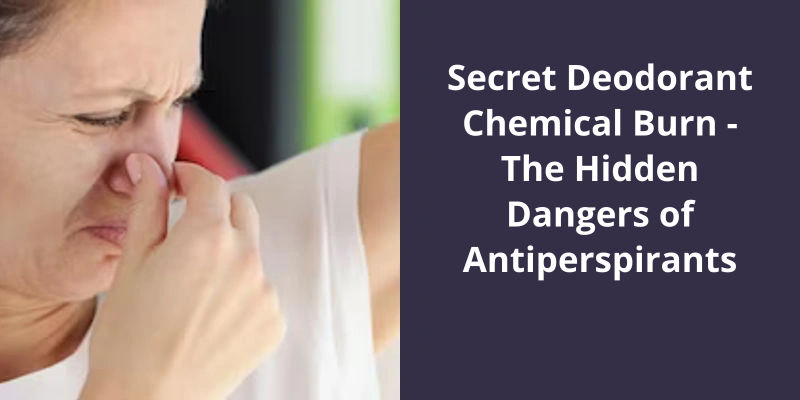Secret Deodorant chemical burn could potentially occur when certain ingredients in the deodorant irritate the skin. It’s a reaction that some individuals may experience due to sensitivity to elements like alcohol, fragrance or aluminum compounds which are typically found in antiperspirants. These ingredients can cause discomfort, redness, or even a burning sensation, especially if the skin is already damaged or irritated. However, it’s important to distinguish this from normal skin adjustment to a new product. If you’re experiencing persistent burning, it’s advisable to stop using the product immediately and consult with a healthcare professional.

Why Does My Deodorant Give Me a Chemical Burn?
Secret Deodorant Chemical Burn: The Hidden Dangers of Antiperspirants
Many individuals have experienced the discomfort of a chemical burn caused by their deodorants, leaving them wondering, “Why does my deodorant give me a chemical burn?”. The answer lies in the pH levels of these products and their compatibility with our skin.
The pH, or acidity, of our skin plays a crucial role in maintaining a healthy barrier against external irritants. Skin pH typically ranges from slightly acidic to neutral, around 5.5 to 6.However, certain deodorants may contain ingredients with higher or lower pH levels, disrupting the delicate balance of our skins acid mantle. This disturbance can result in the formation of a chemical burn.
Sometimes, an ingredient present in the deodorant may not agree with the chemistry of our skin, leading to immediate or long-term irritation. Allergic reactions can differ from person to person, with some individuals experiencing symptoms right away, while others develop sensitivity over time.
Additionally, opting for fragrance-free or hypoallergenic deodorants can help minimize the chances of allergic reactions.
However, even store-bought natural deodorants may cause a burning sensation in some individuals. It’s essential to understand the reasons behind this discomfort and how to address it effectively.
Why Do My Armpits Burn With Natural Deodorant?
One of the reasons why your armpits may burn when using natural deodorant is due to the change in pH that these products cause. Natural deodorants often work by altering the pH of the underarm area, creating an environment that’s less favorable for odor-causing bacteria.
It’s worth noting that the risk of experiencing a chemical burn is typically higher when using DIY deodorant recipes compared to store-bought ones. DIY deodorants often involve blending various ingredients together, with a higher chance of imbalance or improper measurements. This lack of precision can inadvertently create a formulation that’s too harsh or acidic for your skin, resulting in burning and irritation.
These commercially available options tend to have a more balanced formulation that’s less likely to cause adverse skin reactions. Additionally, it’s essential to read and follow the instructions provided with the product, as this will help ensure proper application and minimize the risk of burning.
If you do experience burning or irritation when using a natural deodorant, it’s important to discontinue it’s use immediately. Give your underarms a break and allow the skin to heal before trying a different natural deodorant or consulting a dermatologist for further guidance. Remember, everyones skin is unique, and trial-and-error may be necessary to find a natural deodorant that works well for you without causing any discomfort or burning sensation.
How to Treat and Heal Skin Irritation and Burning Caused by Natural Deodorant
If you experience skin irritation or burning caused by natural deodorant, there are several steps you can take to treat and heal the affected area. Firstly, stop using the deodorant that’s causing the irritation and allow your skin to breathe. Wash the affected area gently with mild soap and warm water to remove any residue. Avoid scrubbing or rubbing the area vigorously, as this can worsen the irritation. Applying a cold compress or ice pack wrapped in a cloth can help soothe the burning sensation. It’s also important to keep the area clean and dry to prevent further irritation. You can apply a thin layer of aloe vera gel or a fragrance-free moisturizer to help calm the skin and promote healing. If the irritation persists or worsens, consult a healthcare professional for further guidance and treatment.
Source: Why do some deodorants cause rash or itching? – Everkind
In addition to the previous findings, three more Secret brand deodorants have been discovered to contain benzene, albeit at levels below the FDA standard of 2ppm. These products include Secret Cool Light & Airy Smooth Feel in both regular and Waterlily scents, with average benzene contamination levels of 1.64ppm and 1.35ppm respectively.
Which Secret Deodorants Have Benzene?
Recently, there have been concerns raised about the presence of benzene in certain Secret brand deodorants. Benzene is a known carcinogen and isn’t supposed to be present in consumer products at levels above 2 parts per million (ppm) as per the FDA standard.
Benzene is a chemical that’s widely used in industries such as petroleum, rubber manufacturing, and chemical production. It’s primarily used as a solvent and in the production of various chemicals. However, it’s a known carcinogen and prolonged exposure to high levels of benzene can lead to serious health issues, including cancer.
This highlights the importance of thorough testing and regulation in ensuring consumer safety.
Consumers may want to consider alternatives to these specific Secret deodorant variants until further information or reassurances are provided regarding their safety. It’s essential for companies to prioritize the safety and well-being of consumers by ensuring that their products are free from harmful contaminants.
After washing off the chemical, it’s important to assess the severity of the burn. If necessary, remove any contaminated clothing or jewelry, avoiding further irritation. Applying a cool, wet compress or a clean cloth to the affected area can help alleviate pain and minimize swelling. However, it’s crucial to seek medical attention for any chemical burn, especially if it covers a large area, affects the face, hands, feet, or genitals, or if it’s caused by a strong acid or alkali.
How Can I Treat a Chemical Burn?
After washing off the chemical burn with water, it’s important to remove any contaminated clothing or accessories to prevent further contact with the chemical. Gently pat the affected area dry with a clean towel, being careful not to rub or irritate the skin further.
Once the area is dry, you can apply a cool compress or immerse the affected area in cool water to help alleviate pain and reduce swelling. Avoid using ice directly on the burn as it can cause further damage to the skin.
To protect the burn from infection, it’s recommended to apply a sterile bandage or non-stick dressing. This will help keep the area clean and provide a barrier against any potential irritants or contaminants.
Over-the-counter pain relievers, such as ibuprofen or acetaminophen, can also be taken to help manage any pain or discomfort associated with the chemical burn. However, it’s important to follow the dosage instructions and consult with a healthcare professional if you’ve any underlying medical conditions or are taking other medications.
If the burn is severe or covers a large area of the body, it’s crucial to seek immediate medical attention. Chemical burns can cause extensive damage to the skin and underlying tissues, requiring specialized treatment to promote healing and prevent complications. A healthcare professional can assess the severity of the burn and provide appropriate medical intervention.
In some cases, additional treatments may be necessary to aid in the healing process, such as the application of topical ointments, antibiotics to prevent infection, or specialized dressings to promote wound healing. Follow-up care may also be required to monitor the progress of the burn and ensure proper healing.
First Aid for Chemical Burns: This Topic Can Expand on the Initial Steps to Take When Treating a Chemical Burn, Including Emergency First Aid Techniques Such as Flushing With Water and Removing Contaminated Clothing.
In cases of chemical burns, it’s crucial to provide immediate first aid to minimize further damage. The initial steps for treating chemical burns involve flushing the affected area with water for at least 20 minutes. This helps to remove any remaining chemical substance on the skin and dilute it’s effects. It’s important to carefully remove any contaminated clothing while flushing the burn.
However, it’s important to note that Procter & Gamble, the manufacturer of Old Spice and Secret deodorants, is currently facing a class-action lawsuit regarding the presence of cancer-causing chemicals in their products. The lawsuit alleges that the deodorant sprays contain benzene, a known carcinogen. The plaintiff, Otto Delcid, is seeking damages for himself and others who’ve purchased these products.
What Deodorant Company Is Being Sued?
A class-action lawsuit has been filed against Procter & Gamble, the company behind Old Spice and Secret deodorants. The lawsuit alleges that these popular deodorant brands contain cancer-causing chemicals, specifically benzene. Benzene is a known carcinogen and can have serious health risks when exposed to it.
The plaintiff, Otto Delcid, filed the complaint in a District Court of New York, seeking damages for himself and others who’ve purchased deodorant sprays that contain benzene. The lawsuit claims that Procter & Gamble failed to adequately warn consumers about the presence of this dangerous chemical in their products.
Old Spice is a well-known American brand of male grooming products, including aftershaves, deodorants, and antiperspirants. It’s been on the market for many years and is widely used by men around the world. Secret, on the other hand, was launched as the first female deodorant in 1956 and is the only female brand in Procter & Gambles portfolio of products.
This lawsuit highlights the hidden dangers of antiperspirants and raises concerns about the chemicals used in these products. It serves as a reminder for consumers to be aware of the ingredients in the personal care products they use and to consider safer alternatives. While the lawsuit is still ongoing, it brings attention to the need for increased transparency and regulation in the cosmetics industry.
Consumers should be vigilant about the ingredients in personal care products and consider safer alternatives.
Safer Alternatives to Traditional Deodorants and Antiperspirants
- Natural deodorants made from plant-based ingredients
- Mineral salt deodorants
- Crystal deodorants
- Baking soda-based deodorants
- Deodorant sprays without harmful chemicals
- Charcoal-based deodorant solutions
- Essential oil-based deodorants
- Aluminum-free deodorant options
- Cream-based deodorants without parabens
- Deodorant wipes with natural ingredients
If you find yourself with a potential chemical burn from deodorant, it’s essential to take immediate action. Start by removing any dry chemicals by brushing them off with gloves. Next, remove any contaminated clothing or jewelry and rinse the affected area under running water for at least 20 minutes. If possible, use a shower for a more thorough rinse. Afterward, consider bandaging the burn to protect it from further irritation. If necessary, repeat the rinsing process.
What to Do if You Get a Chemical Burn From Deodorant?
If you find yourself experiencing a chemical burn from deodorant, it’s crucial to take immediate action. The first step is to remove any dry chemicals from the affected area. To accomplish this, it’s advisable to put on gloves and carefully brush off any remaining material. This will help prevent further damage and irritation.
Once the dry chemicals have been removed, it’s important to eliminate any contaminated clothing or jewelry that may have come into contact with the burn. Afterward, rinse the affected area thoroughly with water for at least 20 minutes. If a shower is available, it can be beneficial to utilize it for this purpose. The continuous flow of water can help flush out any remaining chemicals and provide relief to the burn.
After rinsing, it’s advisable to carefully bandage the burn to protect it from further irritation and potential infection. This step is especially crucial if the burn is in a location prone to rubbing against clothing or other surfaces. By covering the burn with a bandage, you can create a barrier that helps promote healing and prevents any additional harm.
It’s important to note that in some cases, additional rinsing may be necessary. If you feel that the burn is still causing discomfort or if you notice any signs of worsening, it’s recommended to rinse the area again with water. This can help provide further relief and ensure that all remaining chemical residue is eliminated.
Signs and Symptoms of a Chemical Burn From Deodorant: This Topic Could Cover Common Signs and Symptoms of a Chemical Burn From Deodorant, Such as Redness, Blistering, Pain, and Swelling. It Could Also Provide Information on When to Seek Medical Attention.
Chemical burns from deodorant can cause various signs and symptoms that include redness, blistering, pain, and swelling. These burns can be quite uncomfortable and may require immediate medical attention. If you experience any of these symptoms after using a deodorant, it’s important to seek medical help as soon as possible to prevent further complications.
Conclusion
Consumers should be cautious of the potential risks associated with prolonged and excessive usage of antiperspirants, and be proactive in researching the ingredients before making a purchase. It’s crucial for manufacturers to prioritize safety and transparency by thoroughly testing their products and providing clear and accurate information to the consumers. By advocating for safer and healthier options, individuals can protect themselves from potential harm and ensure their well-being in the long run.





